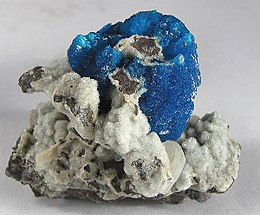| Cavansite | |
|---|---|
 Cavansite on heulandite | |
| General | |
| Category | Silicate mineral |
| Formula (repeating unit) | Ca(VO)Si4O10·4(H2O) |
| IMA symbol | Cav[1] |
| Crystal system | Orthorhombic |
| Crystal class | Dipyramidal (mmm) H–M Symbol: (2/m 2/m 2/m) |
| Space group | Pcmn |
| Unit cell | a = 9.792(2) Å, b = 13.644(3) Å, c = 9.629(2) Å; Z = 4 |
| Identification | |
| Color | Brilliant sky-blue to greenish blue |
| Crystal habit | Radiating acicular prismatic crystals commonly as spherulitic rosettes |
| Cleavage | Good on {010} |
| Tenacity | Brittle |
| Mohs scale hardness | 3 - 4 |
| Luster | Vitreous, pearly |
| Streak | Bluish-white |
| Diaphaneity | Transparent |
| Specific gravity | 2.25 - 2.33 |
| Optical properties | Biaxial (+) |
| Refractive index | nα = 1.542(2) nβ = 1.544(2) nγ = 1.551(2) |
| Birefringence | δ = 0.009 |
| Pleochroism | Visible: X=Z= colorless Y= blue |
| 2V angle | Measured: 52° |
| References | [2][3][4][5] |
Cavansite, named for its chemical composition of calcium vanadium silicate, is a deep blue hydrous calcium vanadium phyllosilicate mineral, occurring as a secondary mineral in basaltic and andesitic rocks along with a variety of zeolite minerals. Its blue coloring comes from vanadium, a metal ion.[6] Discovered in 1967 in Malheur County, Oregon, cavansite is a relatively rare mineral. It is polymorphic with the even rarer mineral, pentagonite. It is most frequently found in Pune, India, and in the Deccan Traps, a large igneous province.
- ^ Warr, L.N. (2021). "IMA–CNMNC approved mineral symbols". Mineralogical Magazine. 85 (3): 291–320. Bibcode:2021MinM...85..291W. doi:10.1180/mgm.2021.43. S2CID 235729616.
- ^ Mineralienatlas
- ^ Handbook of Mineralogy
- ^ Mindat
- ^ Cavansite Mineral Data, Mineralogy Database webmineral.com
- ^ "Minerals Colored by Metal Ions". minerals.gps.caltech.edu. Retrieved 2023-02-28.